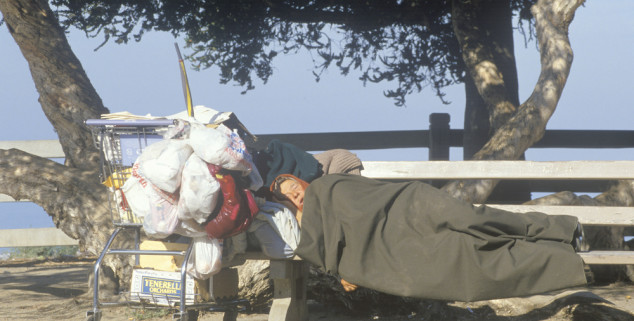News
In limbo, California’s “hidden poor” face health woes
 A homeless woman sleeps on a park bench in Santa Monica. (Photo: Joseph Sohm
A homeless woman sleeps on a park bench in Santa Monica. (Photo: Joseph SohmThey’re called the “hidden poor.”
Stuck in the limbo above the federal poverty level yet below adequate income streams to make ends meet, these “hidden poor” are often a forgotten demographic.
And whereas only 12% of older adults with adequate income reported “difficulty obtaining timely medical care,” that number jumped to 22% for the hidden poor.
Why is identifying the “hidden poor” so important? On average, their health is much worse than their wealthier neighbors – and thus more expensive to treat – yet they are rarely included in health statistics.
“The hidden poor get lumped into that other (wealthier) category and get lost,” says Steven P. Wallace, associate director of the UCLA Center for Health Policy Research.
Among California adults 65 and over, there are more than twice as many hidden poor as those in poverty – 655,000 compared to 259,000.
Wallace is the co-author of a recent UCLA fact sheet that illuminates the true health woes of these hidden poor. While just 17.5% of Californians with adequate income reported fair or poor health, that number nearly doubled to 34% among the hidden poor. (The figured reached almost 50% for those in poverty.)
And whereas only 12% of older adults with adequate income reported “difficulty obtaining timely medical care,” that number jumped to 22% for the hidden poor. (It climbed to nearly 31% for those in poverty.)
Why are these statistics so important?
“Once policy makers acknowledge that many seniors have incomes just above the official poverty line – but are unable to make ends meet – then they can move to (improve) policies,” says Wallace.
Wallace suggests that expanding the amount of affordable housing in California and increasing income streams – Social Security or SSI/SSP (Supplemental Security Income/State Supplementary Payment) – would go a long way towards improving the health outcomes for these hidden poor.
The UCLA Center for Health Policy Research has also long supported increasing the federal poverty level (FPL) for Californians — which is now just $11,770 for a single person (living alone or with a spouse or partner) – claiming older adults need twice this amount to make ends meet in the state.
Income levels for the hidden poor are above the FPL yet under $23,364, which is the actual cost of living for single renters as tallied by the Elder Index – a statewide index detailing the true costs of living in each county.
Health statistics are especially problematic for ethnic Californians. Over half of older adult Latinos, African-Americans and Asian-Americans fall below the Elder Index and are considered either in poverty or members of the hidden poor.
–|
Ed’s Note: Matt Perry is a reporter for California Health Report, where this story originally appeared on March 3.
Want to see more stories like this? Sign up for The Roundup, the free daily newsletter about California politics from the editors of Capitol Weekly. Stay up to date on the news you need to know.
Sign up below, then look for a confirmation email in your inbox.

Leave a Reply